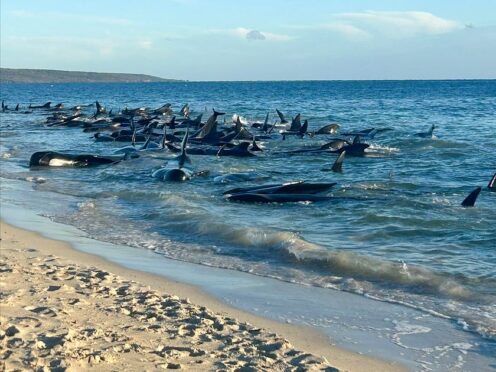
More than 100 long-finned pilot whales that beached on the western Australian coast have returned to sea – while 31 died on the shore, a whale researcher said.
Researcher Ian Wiese joined hundreds of volunteers who helped rescue the whales at Toby’s Inlet near the tourist town of Dunsborough.
“There were well over 200 along the beach here and just nearby and there’s 31, I think, deceased but the rest got away, which is an amazing story,” Mr Wiese told Australian Broadcasting Corp.
“When I first arrived, there was, I think, 160 in the water — almost out of the water — and there were a couple of hundred people who were with the whales, they were trying to comfort them and make sure that their heads were out of the water so they could breathe.
“And then after an hour or so, all of a sudden the ones that were in the water that were still alive left and went out to sea,” Mr Wiese said.
“They may well decide to come back to shore somewhere on another beach nearby or something — that often happens, but we’re hopeful that they won’t,” he added.
The Department of Biodiversity, Conservation and Attractions has yet to confirm the rescues.
A team of wildlife officers, marine scientists and veterinarians had earlier reached the scene and reported 26 dead among up to 160 stranded.
At that time, an additional 20 whales were in a pod about a mile offshore and 110 whales formed a pod closer to the beach, the department said.
Regional wildlife officer Pia Courtis said the pod of 110 whales was “sticking together offshore” and was likely to come toward the beach.
“Unfortunately the outcome for our pilot whales once they strand on the beach is generally not good. We have high numbers of animals that end up dying,” Ms Courtis said.
In July, almost 100 long-finned pilot whales died or were euthanised after a two-day rescue attempt in a mass stranding on Cheynes Beach near the former whaling station of Albany, 220 miles south east of Dunsborough.
Dunsborough is 177 miles by road south of Perth, Western Australia state’s capital and largest city.
Based on previous strandings, including the 2023 Cheynes Beach event, euthanising the beached whales is usually the most humane outcome, the department said in a statement.
“We always hope for the best outcome,” the statement said.
Mr Wiese said Thursday was the third mass stranding he had responded to and the result was by far the best.
“It’s been a very good story today because normally with these sorts of strandings, you wind up with a 100 whales beaching and five or six being saved,” Mr Wiese said.
Ms Courtis said the whales were believed to have become stranded early on Thursday.
The dead whales were dragged from the water so that their carcasses did not attract sharks.
Dunsborough was the scene of a mass stranding of 320 long-finned pilot whales in 1996. Only 20 died on that occasion, with rescuers returning the rest to sea.
Scientists do not know what causes whales to strand, although it appears their location systems can be confused by gently sloping, sandy beaches.
Theories include that they are avoiding predators such as killer whales, or following a sick leader ashore. Human-made undersea noise could also interfere with their navigation.

Enjoy the convenience of having The Sunday Post delivered as a digital ePaper straight to your smartphone, tablet or computer.
Subscribe for only £5.49 a month and enjoy all the benefits of the printed paper as a digital replica.
Subscribe